1973
Introduction of the EP-10, Roland’s first all-electronic, oscillation-based combo piano
 In this era, oscillation of the tone/bar and lead with electricity was the mainstream in electronic piano technology, and the introduction of the all-electronic, oscillation-based piano engine was a big leap forward. In this era, oscillation of the tone/bar and lead with electricity was the mainstream in electronic piano technology, and the introduction of the all-electronic, oscillation-based piano engine was a big leap forward.
|
1974
The debut of the EP-30, the world’s first electronic piano with a touch-sensitive keyboard
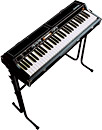 The touch-sensitive keyboard — one that senses playing velocities from soft to hard — is standard technology in today’s digital pianos. However, in the early days of electronic piano technology, it was a groundbreaking advancement. The touch-sensitive keyboard — one that senses playing velocities from soft to hard — is standard technology in today’s digital pianos. However, in the early days of electronic piano technology, it was a groundbreaking advancement.
|
1975
Roland introduces Japan’s first genuine digital pianos for home use (HP-750R/HP-760M/HP-860R/HP-870M/HP-872M)
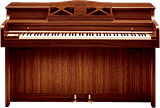 Equipped with hammer-action keyboards and wooden cabinets, these pioneering instruments set the standard for today’s digital pianos. Equipped with hammer-action keyboards and wooden cabinets, these pioneering instruments set the standard for today’s digital pianos.
|
1980
The debut of the EP-09
 A portable electronic piano equipped with a CPU and keyboard split and auto-arpeggiator functions. A portable electronic piano equipped with a CPU and keyboard split and auto-arpeggiator functions.
|
1981
The debut of the wood-finished HP-60 and HP-70 compact pianos
 These compact performance pianos featured a stylish design, excellent sound quality, and onboard speakers. These compact performance pianos featured a stylish design, excellent sound quality, and onboard speakers.
|
1983
The HP-300 and HP-400, the first digital pianos with MIDI
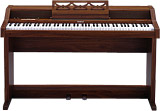 These digital pianos were the first to incorporate MIDI, an industry-standard protocol that enables digital musical instruments to communicate with each other. Their new two-piece cabinet design (main body and stand) was another innovation that became mainstream thereafter. These digital pianos were the first to incorporate MIDI, an industry-standard protocol that enables digital musical instruments to communicate with each other. Their new two-piece cabinet design (main body and stand) was another innovation that became mainstream thereafter.
|
1986
Introduction of the RD-1000 Stage Piano
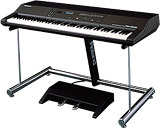 Equipped with Roland’s cutting-edge SA (Structured Adaptive) sound engine — the era’s very latest digital technology — this piano set a new standard for expressiveness and realism. Roland has retained the “RD” designation for its stage piano models to this day. Equipped with Roland’s cutting-edge SA (Structured Adaptive) sound engine — the era’s very latest digital technology — this piano set a new standard for expressiveness and realism. Roland has retained the “RD” designation for its stage piano models to this day.
|
1987
The debut of home pianos equipped with the SA sound engine (HP-5600S/HP-5500S/HP-4500S/HP-3000S)
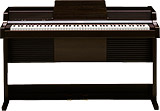 Roland brings its advanced SA technology to the home market. Roland brings its advanced SA technology to the home market.
Concerts to explore the future of music held in Tokyo and Osaka
A lineup of digital musical instruments — with the RD-1000 featured — co-star with a symphony orchestra in performances that celebrate the integration of digital instruments with traditional acoustic instruments. |
1989
The debut of the KR-3000L, the first digital piano with onboard auto-accompaniment
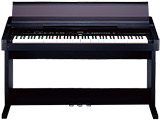 With this touchstone product, home pianists could now enjoy playing along with “music styles” featuring both rhythm and chord backing in musical genres from all over the world. To this day, music styles continue to be an integral part of Roland’s KR-Series models. With this touchstone product, home pianists could now enjoy playing along with “music styles” featuring both rhythm and chord backing in musical genres from all over the world. To this day, music styles continue to be an integral part of Roland’s KR-Series models.
|
1990
Introduction of the HP-2700/HP-3700 with the advanced SA sound engine
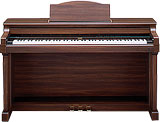 These models integrated Roland’s award-winning SA sound technology with a newly designed furniture-grade cabinet, changing the image of the home-based digital piano forever. These models integrated Roland’s award-winning SA sound technology with a newly designed furniture-grade cabinet, changing the image of the home-based digital piano forever.
|
1991
Introduction of the FP-8, a portable piano with 88 keys
 The fashionable red/white/gray color scheme was an instant success, as was the hammer-action keyboard. Incorporating a key mechanism with only a weight hammer and no springs, this keyboard’s feel rivaled the natural touch of an acoustic piano. The fashionable red/white/gray color scheme was an instant success, as was the hammer-action keyboard. Incorporating a key mechanism with only a weight hammer and no springs, this keyboard’s feel rivaled the natural touch of an acoustic piano.
|
1992
The debut of the HP-7700, a digital grand piano
 This instrument combined the compact size of digital piano electronics with the majestic and elegant look of an acoustic grand. This instrument combined the compact size of digital piano electronics with the majestic and elegant look of an acoustic grand.
|
1992
The introduction of the HP-2900G, equipped with a floppy disk drive
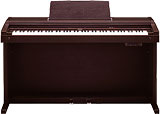 This instrument featured a high-quality piano sound along with the sounds of over 200 other instruments. With the onboard floppy disk drive, users could enjoy playing along with accompaniment from a large library of Music Data disks. This instrument featured a high-quality piano sound along with the sounds of over 200 other instruments. With the onboard floppy disk drive, users could enjoy playing along with accompaniment from a large library of Music Data disks.
|
1996
The debut of the KR-570, the first digital piano with a large graphical LCD panel
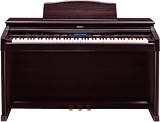 The fast-paced growth of digital technology allowed Roland to include more and more features into its digital pianos, and the large display in this new instrument made it easier for the user to access and operate them all. The fast-paced growth of digital technology allowed Roland to include more and more features into its digital pianos, and the large display in this new instrument made it easier for the user to access and operate them all.
|
2000
The Hammer-Action Keyboard with Escapement is first introduced
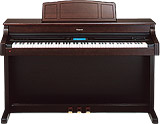 Included in 2000’s HP-557R, HP-337R, and KR-577 piano models, this groundbreaking keyboard mechanism featured progressive hammer-action keys with no springs. This brought the acoustic grand piano’s characteristic “click” feel to digital pianos, along with a traditional heavy touch on the lower notes and a light touch on the higher notes. Included in 2000’s HP-557R, HP-337R, and KR-577 piano models, this groundbreaking keyboard mechanism featured progressive hammer-action keys with no springs. This brought the acoustic grand piano’s characteristic “click” feel to digital pianos, along with a traditional heavy touch on the lower notes and a light touch on the higher notes.
|
2001
The debut of the F-90, featuring a slim and compact design, and stylish finish
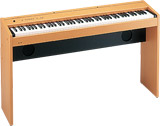 This top-selling piano became extremely popular thanks to its genuine piano sound and simple, compact body. This top-selling piano became extremely popular thanks to its genuine piano sound and simple, compact body.
|
2002
The introduction of the HPi-5 with DigiScore™, an LCD built into the music rack
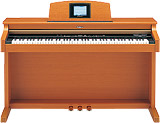 The groundbreaking DigiScore feature introduced a new way of practicing the piano, with a notation display (with automatic page turning) for the built-in piano songs, commercial music data, and song lyrics. It also displayed the user’s playing as notation in real time. The groundbreaking DigiScore feature introduced a new way of practicing the piano, with a notation display (with automatic page turning) for the built-in piano songs, commercial music data, and song lyrics. It also displayed the user’s playing as notation in real time.
|
2003
The introduction of the stylish DP-900 Designer Piano
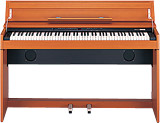 With a depth of just 30 cm and a flat top with the lid closed, this simple and elegant piano instantly became a big hit. With a depth of just 30 cm and a flat top with the lid closed, this simple and elegant piano instantly became a big hit.
|
2004
The debut of the HPi-7, equipped with the largest DigiScore display yet
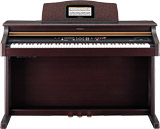 The extra-wide, full-color DigiScore display made piano practice more enjoyable than ever. The extra-wide, full-color DigiScore display made piano practice more enjoyable than ever.
|
2005
The RG-7 captures the form and sound of an acoustic grand piano
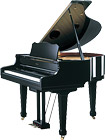 Equipped with the new 88-Key Multi-Sampled Piano Engine, the RG-7 captured the unique, expressive sound of every note on an acoustic grand piano. The instrument was also equipped with a “moving keys” feature that automatically moved the keys as the built-in demo songs played. Equipped with the new 88-Key Multi-Sampled Piano Engine, the RG-7 captured the unique, expressive sound of every note on an acoustic grand piano. The instrument was also equipped with a “moving keys” feature that automatically moved the keys as the built-in demo songs played.
|
2008
The chic and modern LX-10 opens a new era in digital piano design
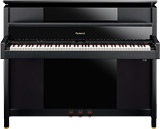 This groundbreaking piano combines the superb sound and elegant finish of a grand piano with the space-saving design of an upright, and features a newly designed speaker system for unparalleled sound quality. This groundbreaking piano combines the superb sound and elegant finish of a grand piano with the space-saving design of an upright, and features a newly designed speaker system for unparalleled sound quality.
|
2009
The revolutionary V-Piano® is born
 Roland reinvents piano technology with the V-Piano, a modeling-based digital instrument that uses no sampling whatsoever. With its groundbreaking “living” piano engine, the V-Piano is able to create the sounds of nearly any piano, both real and imagined. Roland reinvents piano technology with the V-Piano, a modeling-based digital instrument that uses no sampling whatsoever. With its groundbreaking “living” piano engine, the V-Piano is able to create the sounds of nearly any piano, both real and imagined.
|
2010
The debut of the SuperNATURAL® Piano Series
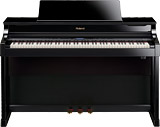 The new SuperNATURAL Pianos come equipped with the SuperNATURAL Piano sound engine, a breakthrough technology that offers unprecedented sound, response, and feel. The new SuperNATURAL Pianos come equipped with the SuperNATURAL Piano sound engine, a breakthrough technology that offers unprecedented sound, response, and feel.
|
2011
Roland introduces the V-Piano® Grand
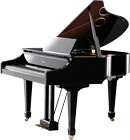 This exquisite instrument blurs the line between digital and acoustic worlds. Stepping up from the previous generation, the V-Piano Grand’s sound generator has been further refined to create the world’s first “stringless acoustic piano.” This exquisite instrument blurs the line between digital and acoustic worlds. Stepping up from the previous generation, the V-Piano Grand’s sound generator has been further refined to create the world’s first “stringless acoustic piano.”
|

 The touch-sensitive keyboard — one that senses playing velocities from soft to hard — is standard technology in today’s digital pianos. However, in the early days of electronic piano technology, it was a groundbreaking advancement.
The touch-sensitive keyboard — one that senses playing velocities from soft to hard — is standard technology in today’s digital pianos. However, in the early days of electronic piano technology, it was a groundbreaking advancement. Equipped with hammer-action keyboards and wooden cabinets, these pioneering instruments set the standard for today’s digital pianos.
Equipped with hammer-action keyboards and wooden cabinets, these pioneering instruments set the standard for today’s digital pianos. A portable electronic piano equipped with a CPU and keyboard split and auto-arpeggiator functions.
A portable electronic piano equipped with a CPU and keyboard split and auto-arpeggiator functions. These compact performance pianos featured a stylish design, excellent sound quality, and onboard speakers.
These compact performance pianos featured a stylish design, excellent sound quality, and onboard speakers. These digital pianos were the first to incorporate MIDI, an industry-standard protocol that enables digital musical instruments to communicate with each other. Their new two-piece cabinet design (main body and stand) was another innovation that became mainstream thereafter.
These digital pianos were the first to incorporate MIDI, an industry-standard protocol that enables digital musical instruments to communicate with each other. Their new two-piece cabinet design (main body and stand) was another innovation that became mainstream thereafter. Equipped with Roland’s cutting-edge SA (Structured Adaptive) sound engine — the era’s very latest digital technology — this piano set a new standard for expressiveness and realism. Roland has retained the “RD” designation for its stage piano models to this day.
Equipped with Roland’s cutting-edge SA (Structured Adaptive) sound engine — the era’s very latest digital technology — this piano set a new standard for expressiveness and realism. Roland has retained the “RD” designation for its stage piano models to this day. Roland brings its advanced SA technology to the home market.
Roland brings its advanced SA technology to the home market. With this touchstone product, home pianists could now enjoy playing along with “music styles” featuring both rhythm and chord backing in musical genres from all over the world. To this day, music styles continue to be an integral part of Roland’s KR-Series models.
With this touchstone product, home pianists could now enjoy playing along with “music styles” featuring both rhythm and chord backing in musical genres from all over the world. To this day, music styles continue to be an integral part of Roland’s KR-Series models. These models integrated Roland’s award-winning SA sound technology with a newly designed furniture-grade cabinet, changing the image of the home-based digital piano forever.
These models integrated Roland’s award-winning SA sound technology with a newly designed furniture-grade cabinet, changing the image of the home-based digital piano forever. The fashionable red/white/gray color scheme was an instant success, as was the hammer-action keyboard. Incorporating a key mechanism with only a weight hammer and no springs, this keyboard’s feel rivaled the natural touch of an acoustic piano.
The fashionable red/white/gray color scheme was an instant success, as was the hammer-action keyboard. Incorporating a key mechanism with only a weight hammer and no springs, this keyboard’s feel rivaled the natural touch of an acoustic piano. This instrument combined the compact size of digital piano electronics with the majestic and elegant look of an acoustic grand.
This instrument combined the compact size of digital piano electronics with the majestic and elegant look of an acoustic grand. This instrument featured a high-quality piano sound along with the sounds of over 200 other instruments. With the onboard floppy disk drive, users could enjoy playing along with accompaniment from a large library of Music Data disks.
This instrument featured a high-quality piano sound along with the sounds of over 200 other instruments. With the onboard floppy disk drive, users could enjoy playing along with accompaniment from a large library of Music Data disks. The fast-paced growth of digital technology allowed Roland to include more and more features into its digital pianos, and the large display in this new instrument made it easier for the user to access and operate them all.
The fast-paced growth of digital technology allowed Roland to include more and more features into its digital pianos, and the large display in this new instrument made it easier for the user to access and operate them all. Included in 2000’s HP-557R, HP-337R, and KR-577 piano models, this groundbreaking keyboard mechanism featured progressive hammer-action keys with no springs. This brought the acoustic grand piano’s characteristic “click” feel to digital pianos, along with a traditional heavy touch on the lower notes and a light touch on the higher notes.
Included in 2000’s HP-557R, HP-337R, and KR-577 piano models, this groundbreaking keyboard mechanism featured progressive hammer-action keys with no springs. This brought the acoustic grand piano’s characteristic “click” feel to digital pianos, along with a traditional heavy touch on the lower notes and a light touch on the higher notes. This top-selling piano became extremely popular thanks to its genuine piano sound and simple, compact body.
This top-selling piano became extremely popular thanks to its genuine piano sound and simple, compact body. The groundbreaking DigiScore feature introduced a new way of practicing the piano, with a notation display (with automatic page turning) for the built-in piano songs, commercial music data, and song lyrics. It also displayed the user’s playing as notation in real time.
The groundbreaking DigiScore feature introduced a new way of practicing the piano, with a notation display (with automatic page turning) for the built-in piano songs, commercial music data, and song lyrics. It also displayed the user’s playing as notation in real time. With a depth of just 30 cm and a flat top with the lid closed, this simple and elegant piano instantly became a big hit.
With a depth of just 30 cm and a flat top with the lid closed, this simple and elegant piano instantly became a big hit. The extra-wide, full-color DigiScore display made piano practice more enjoyable than ever.
The extra-wide, full-color DigiScore display made piano practice more enjoyable than ever. Equipped with the new 88-Key Multi-Sampled Piano Engine, the RG-7 captured the unique, expressive sound of every note on an acoustic grand piano. The instrument was also equipped with a “moving keys” feature that automatically moved the keys as the built-in demo songs played.
Equipped with the new 88-Key Multi-Sampled Piano Engine, the RG-7 captured the unique, expressive sound of every note on an acoustic grand piano. The instrument was also equipped with a “moving keys” feature that automatically moved the keys as the built-in demo songs played. This groundbreaking piano combines the superb sound and elegant finish of a grand piano with the space-saving design of an upright, and features a newly designed speaker system for unparalleled sound quality.
This groundbreaking piano combines the superb sound and elegant finish of a grand piano with the space-saving design of an upright, and features a newly designed speaker system for unparalleled sound quality. Roland reinvents piano technology with the V-Piano, a modeling-based digital instrument that uses no sampling whatsoever. With its groundbreaking “living” piano engine, the V-Piano is able to create the sounds of nearly any piano, both real and imagined.
Roland reinvents piano technology with the V-Piano, a modeling-based digital instrument that uses no sampling whatsoever. With its groundbreaking “living” piano engine, the V-Piano is able to create the sounds of nearly any piano, both real and imagined. The new SuperNATURAL Pianos come equipped with the SuperNATURAL Piano sound engine, a breakthrough technology that offers unprecedented sound, response, and feel.
The new SuperNATURAL Pianos come equipped with the SuperNATURAL Piano sound engine, a breakthrough technology that offers unprecedented sound, response, and feel. This exquisite instrument blurs the line between digital and acoustic worlds. Stepping up from the previous generation, the V-Piano Grand’s sound generator has been further refined to create the world’s first “stringless acoustic piano.”
This exquisite instrument blurs the line between digital and acoustic worlds. Stepping up from the previous generation, the V-Piano Grand’s sound generator has been further refined to create the world’s first “stringless acoustic piano.”